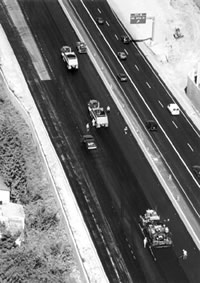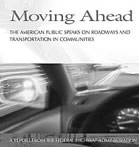U.S. Department of Transportation
Federal Highway Administration
1200 New Jersey Avenue, SE
Washington, DC 20590
202-366-4000
Focus
| Accelerating Infrastructure Innovations |
Publication Number: FHWA-RD-01-064
Date: June 2001
Public satisfaction with the overall condition of the Nation's major highways has risen 15 percentage points over the last 5 years, according to a recently released survey by the Federal Highway Administration (FHWA). Moving Ahead: The American Public Speaks on Roadways and Transportation in Communities, reveals an increase in traveler satisfaction in such areas as pavement condition, safety, bridge conditions, visual appeal of highways and associated infrastructure, and travel amenities, including roadside assistance and number of rest areas. Overall, 65 percent of those surveyed were satisfied with the highways that they travel on.
While overall satisfaction with major highways has increased, the report also revealed some increases in dissatisfaction, particularly in the areas of traffic flow and work zones. Forty-three percent of respondents expressed dissatisfaction with traffic flow, while 32 percent were dissatisfied with work zones. The top three suggested improvements for overcoming travel delay problems were using more durable pavement materials, reducing repair times, and making repairs during non-rush hours.
| "The feedback from the survey will help FHWA focus its resources even more, so as to better meet the needs of our consumers." |
The report notes that while road repairs are an essential and necessary part of managing the Nation's highways, the public feedback indicates the need for smarter construction management practices. Roadwork should be planned and executed effectively to minimize traffic disruptions, and quality construction practices and high-performing materials should be used to minimize the need for recurring work. These goals are reflected in the "Get In-Get Out-Stay Out" method of highway maintenance, which focuses on innovative ways to better manage and carry out construction projects and to improve the quality and durability of the resulting product.
When respondents were asked whether they would be willing to support closing a road in order to conduct long-lasting repairs, 67 percent indicated that they would support a 1-week closure and 37 percent would support even a 1-month closure. However, only 16 percent would support a 3-month closure and fewer than 10 percent would support even longer closings.
 |
|
| The "Get In-Stay Out" method of highway maintenance has been used by States such as Washington, Which cut a full constracution season off a 3-year project by completely closing part of Interstate 405 on two consecutive weekends for rehabilitation work. |
The report also notes that "Improvements in traffic flow, pavement conditions, and work zones may result in the greatest rise in traveler satisfaction. Work zones are especially critical as travelers view road repairs as a major reason for traffic delays." These concerns reflect current areas of emphasis for FHWA and its State department of transportation partners, with ongoing initiatives to build smoother pavements, minimize delays caused by work zones and make them safer, and encourage the use of high-performance materials in pavement and bridge construction.
Survey respondents gave high marks to many highway safety elements, including highway hazard signs (84 percent satisfaction), lane width (80 percent), pavement markings (76 percent), and safety barriers (74 percent). However, safety improvements remain one of the top areas where the public thinks future attention and resources should be focused.
The report also looked at the effects of transportation facilities on the Nation's communities. Respondents were asked a series of questions about how well their community's transportation system, which includes roads, public transportation, and bikeways and pathways, supports desirable lifestyles in their communities. In general, the public was more critical of how well their community needs are served by their transportation systems than they were of highway conditions. Fifty-nine percent of respondents gave their community transportation system fair or poor ratings, while 27 percent gave it a poor rating. The greatest topics of concern relating to communities were congestion, excessive development, and impacts from noise and air pollution.
"The feedback from the survey will help FHWA focus its resources even more, so as to better meet the needs of our customers," says Ken Jacoby of FHWA's Office of Asset Management. "FHWA is committed to obtaining customer satisfaction."
Others in the highway community are also gaining insight from the survey results. "This survey will help us both in strategic planning and more immediate deployment of resources," says Tony Kane of the American Association of State Highway and Transportation Officials.
The report was a compilation of several nationwide surveys that addressed topics ranging from highway conditions and traffic congestion to transportation-related impacts on community development. These surveys were follow-ups to the 1995 National Highway User Survey conducted by the National Quality Initiative. The 2000 survey can be viewed on the Web at www.fhwa.dot.gov/reports/movingahead.htm. For more information, contact Ken Jacoby at FHWA, 202-366-6503 (fax: 202-366-9981; email: ken.jacoby@fhwa.dot.gov).
